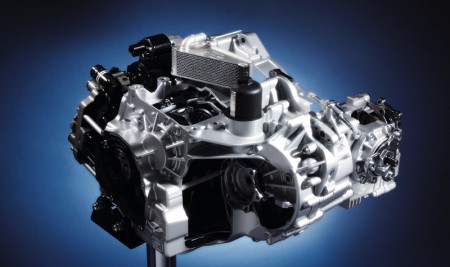
Porsche originally pioneered a working version of the dual clutch gearbox concept on some 962 Group C cars in the late 1980s, but it took until 2003 for the design to show up in production vehicles. When Volkswagen introduced the six speed DSG in various Audi, VW, and Skoda models, it used dual wet clutches in a setup designed and built by Borg-Warner.
The DSG has half the gears connected to one clutch with the other half connected to the second clutch. It works essentially as two interwoven gearboxes tied to a single output. As one clutch is engaged, the other is disengaged and shifted. When it's time to go up or down a gear the corresponding gears on the open clutch are coupled and the two clutches swap positions. At that point the gears on the opposite are coupled in preparation for the next shift.
This year, Volkswagen is introducing a new-generation DSG with an extra gear and dry clutches. The new seven-speed gearbox is more compact than the original and more efficient thanks in part to the dry clutches. Because of its smaller size, the new box can be used in models all the way down to the Polo. VW will start building the new gearboxes late this year and they will appear in the Golf with the 1.4L TSI gas engine and the 1.9L TDI diesel. The 1.4L TSI is also new, and like VW's other TSI engines uses direct fuel injection but uses only a turbocharger rather than the twin turbo/supercharger setup used on the other TSI mills.
[Source: VW]
PRESS RELEASE:
PIONEERING SEVEN-SPEED DSG GEARBOX BREAKS COVER
Volkswagen has developed an evolution of its pioneering DSG gearbox. The new seven-speed system – a world first and codenamed DQ200 – uses a pair of dry clutches in preference to the six-speed version's twin wet clutches. This increases efficiency and performance over the wet clutch six-speed system.
The six-speed DSG gearbox, which was introduced in 2003, uses a pair of clutches submerged in oil. The new seven-speed gearbox adopts a pair of dry, organic bonded friction linings that do not require cooling, making the drivetrain more efficient through the extra ratio and the fact that less power is required for the gear selection and clutch servo system.
For the first time the DSG gearbox has been mounted transversely. Measuring only 369 mm in length and weighing only 79 kg including the dual-mass flywheel the gearbox is remarkably compact. These modest proportions mean it can be applied to models from the Polo right up to the Passat and, in its current form, it is capable of coping with power outputs of up to 170 PS and 184 lbs ft of torque.
In adopting seven-speeds, Volkswagen engineers were able to lower first gear to improve acceleration from a standstill. By contrast seventh gear has been raised to act as an overdrive function making it ideal for motorway driving with the additional effect of raising economy and comfort levels.
The volume of oil contained within the gearbox has also been reduced by 75 per cent. The oil circuits are split into two in an effort to protect the lubrication's purity. As with a conventional manual gearbox, one of the circuits is used for cooling and lubrication of the gear teeth, the second feeds oil to the gear actuators. Since the clutch does not require cooling the quantity of oil was reduced from seven litres in the six-speed DSG gearbox to only 1.7-litres in the new seven-speed system.
Production of the gearbox is set to start at the end of the year with its first application in the UK being planned for the Golf and mated to the 1.4-litre TSI petrol and 1.9-litre TDI diesel engines.
NEW TSI TO REPLACE EXISTING 1.6-LITRE FSI UNIT
Volkswagen is also introducing a new turbocharged 1.4-litre engine to replace the existing 1.6-litre FSI engine. Based on the 1.4-litre TSI engine the new unit is not fitted with a supercharger and instead uses a sophisticated turbocharger. The result is an output of 122 PS linked to a choice of manual or DSG gearboxes.
The new engine is planned to be fitted to the Golf, Golf Plus, Golf Estate, Jetta and Passat models, replacing the current 1.6-litre FSI engine when production commences later this year.


Sign in to post
Please sign in to leave a comment.
Continue